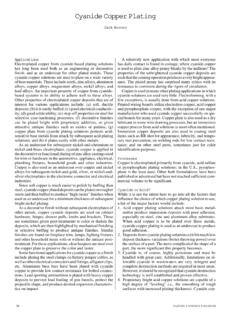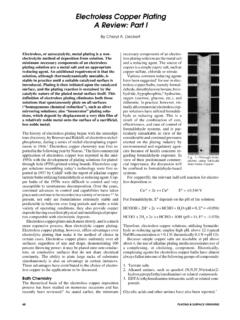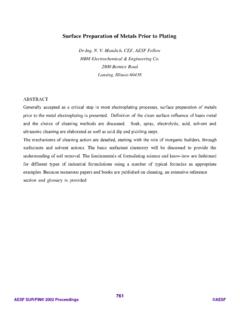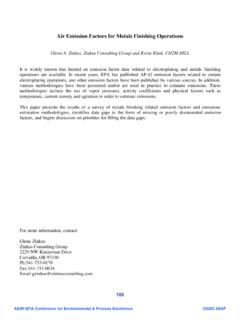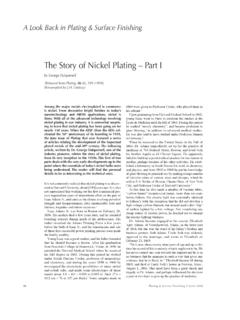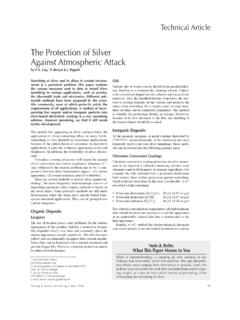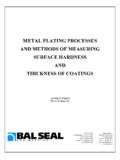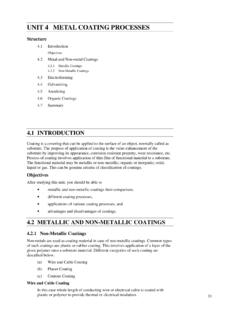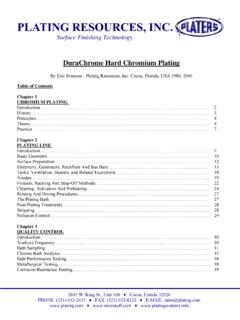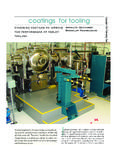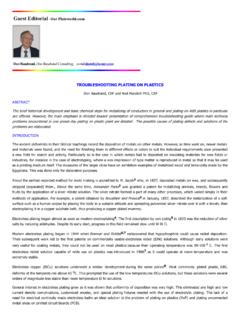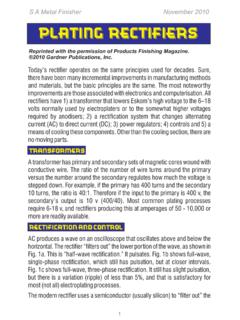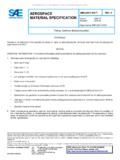Transcription of WORKGROUP REPORT: F006 BENCHMARKING …
1 WORKGROUP report : f006 BENCHMARKING STUDY September 1998 TABLE OF CONTENTSEXECUTIVE is the Common Sense Initiative?.. metal Finishing Industry and Electroplating Wastewater Treatment Sludges .. Sludge Generation and for Listing f006 -Electroplating Wastewater Treatment Sludges as a RCRAH azardous Waste in this Study was Worker Health and Safety.. f006 BENCHMARKING STUDY Regional BENCHMARKING National BENCHMARKING Statistical Analysis of the Regional and National BENCHMARKING Survey of Commercial Survey of Community Environmental RESULTS OF THE f006 BENCHMARKING of Regional and National BENCHMARKING f006 Waste BENCHMARKING Summary Statistical Analysis: Does this Data Come from Typical metal Finishers?
2 243. Results of Commercial Recyclers and Citizen Group Detailed Results of the Regional and National BENCHMARKING The Milwaukee BENCHMARKING Chicago BENCHMARKING Phoenix BENCHMARKING Detailed Results of the National BENCHMARKING A:Summary of the 10 Issue Areas Identified for the metal Finishing B: f006 Management Contained in EPA s 1995 Biennial report C:Observed f006 Handling Practices at metal Finishing Facilities and List of Worker Healthand Safety 19982F006 BENCHMARKING StudyAppendix D:Checklist Used to Identify Pollution Prevention Technologies at metal Finishing E:Laboratory Analysis Information: Constituents, Methods, and Detection Limits Used inthe BENCHMARKING F:Regional BENCHMARKING G:National BENCHMARKING H:National BENCHMARKING Commercial Recyclers I:Responses to Citizen Group Phone J: Statistical Representativeness of the National BENCHMARKING Borst, Paul A.
3 EPA, Office of Solid Waste. Recycling of Wastewater Treatment Sludges from1 Electroplating Operations, f006 . 1997. September 19983F006 BENCHMARKING StudyEXECUTIVE SUMMARYThis report presents current information about the metal finishing industry in the , andis the result of a two year effort of the metal Finishing WORKGROUP of the Common Sense Initiative(CSI). The CSI was begun by the Environmental Protection Agency (EPA) in 1994 to explore cleaner, cheaper, and smarter environmental strategies beyond those required by regulation. Using the special authorities of the Federal Advisory Committee Act (FACA), EPA broughttogether representatives from federal, state, and local governments, industry, community-basedand national environmental interest groups, environmental justice groups and organized labor toexplore opportunities for managing environmental issues in new ways.
4 Six industry sectors werechosen for the initial CSI efforts, including petroleum refining, automobile manufacturing, ironand steel production, electronics, printing and metal of the metal Finishing Industry and Hazardous Waste finishing refers to processes which deposit or plate a thin layer of metal and/orapply an additional organic topcoat as an outer coating on products received from othermanufacturing operations. metal finishing is performed for either functional or decorativepurposes and affects many products we use everyday. For example, hard chrome plating is afunctional plating process that increases the hardness and durability of engine parts. Chromeplating automobile bumpers is an example of a decorative plating process.
5 EPA estimated that there were approximately 13,400 metal finishing establishments in theUnited States. Of the total, approximately 10,000 metal finishing facilities are estimated to be captive shops contained inside a larger manufacturing operation. The balance of 3,400 metalfinishing facilities are job shops or independent metal finishing operations that operate on ajob-specific contract basis. The total number of plating shops has decreased significantly since1the 1970's, mainly as a result of increasing regulations and competition. As in many manufacturing processes, some portion of the materials used in production orin the product itself are not totally captured as salable product, and exit the process inwastewater, solid waste, airborne emissions, scrap metal , or off-spec products.
6 Prior to 1980,there were no federal regulations covering the discharge or disposal of wastes from metalfinishing operations, and the wastes, which contained metals as well as other substances, wereoften directly discharged to surface waters or disposed of in landfills or lagoons. In 1980, EPA issued the Nation s first hazardous waste management regulations, which listed sludges from electroplating wastewater treatment as a hazardous waste ( f006 ), and setstandards for the storage, transportation, treatment and disposal of these sludges. EPAsimultaneously developed regulations that require metal finishers to significantly reduce oreliminate pollutants in wastewaters discharged to publically owned wastewater treatment systems Borst, Paul A.
7 EPA, Office of Solid Waste. Recycling of Wastewater Treatment Sludges from2 Electroplating Operations, f006 . 19984F006 BENCHMARKING Study(final pretreatment regulations were issued in 1986). As a result of the strengthening of the federal regulations, the metal finishing industryimplemented many improvements in material use, production processes and waste managementmethods. Metals contained in f006 have commercial value if they are present in sufficientconcentrations and if other analytes in the sludge are below levels which would interfere with themetal recovery process. There may be other materials contained in the sludge which do notinterfere with metals recovery, but which could be hazardous if improperly managed.
8 Theeconomics of hazardous waste management is a strong determinant of whether metal finisherssend sludges for land disposal or to recycling facilities. Estimates of the amounts of sludge thatare recycled or land disposed vary widely. One source estimates that between 10 and 20 percentis recycled and between 80 and 90 percent is treated and land was this study conducted?The CSI metal Finishing Subcommittee focused on the metal finishing industry s beliefthat process improvements made by many metal finishers during the past 20 years havesignificantly changed the composition of the f006 material that was listed and regulated in 1980,and it is the industry s belief that modification of EPA s hazardous waste regulations for F006could increase the metal finishing industry s ability to recover and recycle more commerciallyvaluable metals from f006 than they currently recover, and simultaneously decrease the amountof metal finishing wastes disposed of in regulated landfills.
9 In order to evaluate the current status of the industry, the Subcommittee formed aworkgroup to complete a characterization of f006 and to report on the results as the foundationfor any further discussions regarding potential modifications to f006 regulations. This report simply presents the data collected during the f006 BENCHMARKING Study as afoundation for further evaluation of f006 . The CSI WORKGROUP did not attempt to analyze thedata to determine the extent to which the characteristics of f006 have changed based on industrypollution prevention practices or other factors. In Phase 2 of this effort, the WORKGROUP willanalyze the information presented in this report , and examine whether potential modifications ofthe current regulations applicable to f006 should be considered by Health and SafetyAs part of the BENCHMARKING study, the WORKGROUP collected information on f006 handlingpractices, identified the potential hazards to workers, and described possible hazard controlSeptember 19985F006 BENCHMARKING Studymethods.
10 In addition, the WORKGROUP developed a list of the current worker health and safetyregulations and policies that may apply to on-site and off-site management of f006 . Thisinformation is presented in Appendix C of this report . Beyond this information, the workgroupdid not attempt to complete a comprehensive review of worker health and safety issues associatedwith f006 indicated above, in Phase II of this effort the WORKGROUP will examine whether possiblemodifications of the current regulations for f006 should be considered based on the informationin this study. As part of this effort, the WORKGROUP will consider potential worker health andsafety issues when examining possible regulatory changes for f006 BENCHMARKING Study ApproachThe WORKGROUP focused on three analytical questions to guide its work on characterizingcurrent practices in the metal finishing industry, and the composition and management of f006 : 1)What are the characteristics of f006 ?
